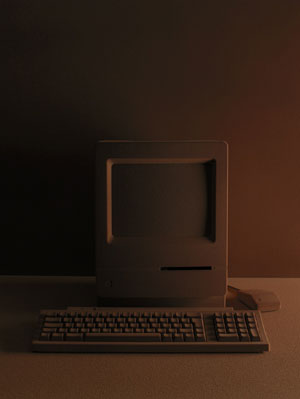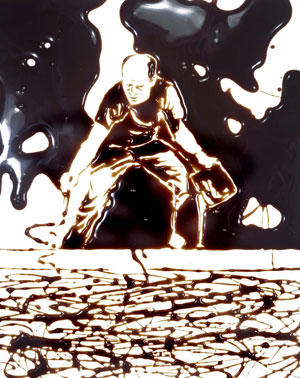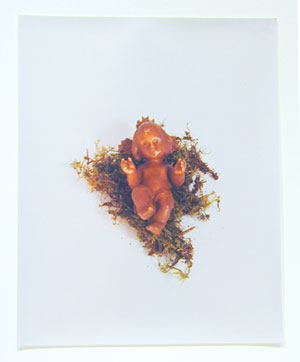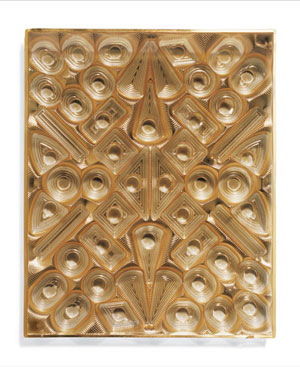The newest contemporary exhibition at the San Antonio Museum of Art, Chocolate: A Photography Exhibition, features four artists working in two mediums: photography as the final object of display and chocolate as its conceptual resource. San Antonio-based artist Chuck Ramirez, French artist Frédéric Lebain, Costa Rican artist Priscilla Monge and Brazilian-born Vik Muniz are reunited in this exhibition to present works that, as curator David S. Rubin, Curator of Contemporary Art at SAMA, states, “reflect a currently widespread artistic practice of finding metaphoric meaning through the use of unconventional and innovative materials.” The dark, natural color of cocoa dominates this show, making it seem rather somber at first glance, although it is quite an interesting concept.
The first work the viewer sees is Chuck Ramirez’s Dark Heart, a photograph of a heart-shaped box of chocolates. To the right of this oh-so-lovely icon of romantic relationships, one discovers a series of images, also of empty chocolate boxes. These have interesting patterns that must have sparked an interest to the graphic design-trained Ramirez. His works are the only ones in the show in which the main ingredient, chocolate, is missing; it is only implied by what one immediately recognizes as chocolate boxes. The viewer’s first reaction is to look for the chocolate, but instead of chocolate Ramirez provides us with eye candy shapes and patterns. His work reminds viewers in a consumerist society that if we take a closer look, the things we discard are beautiful. In this case, the chocolate we eat in a moment of self-indulgence is ultimately temporary. Its package ends up permanently in a landfill and its design is discarded and forgotten. Two of the images, golden Godiva boxes, stand out from the rest — the brand name immediately conjures concepts of social class, and their design recalls golden Byzantine churches, filled with shimmering mosaics and holy images. Embossed indentations appear to form golden rays, alluding to wealth as something divinely inspired.

Frederic Lebain...Untitled (Apple Computer), 2006...archival pigment print, 23 x 17”...Courtesy of Clampart, New York
Frédéric Lebain’s works display images of what appear to be chocolate confections in the shape of obsolete technological equipment, including an early model Macintosh computer and brick-like cellular phone. Lebain actually created these by coating real equipment with chocolate and then freezing them as if they were cakes, combining his skills as a chef, food stylist and photographer. Lebain draws interesting parallels here between the impermanence of photography, chocolate and technology — photography’s objective is to document a temporary moment; chocolate’s inherently fragile form can change in an instant by either consumption or temperature. He adds to this concept by utilizing once cutting-edge technology that has since become obsolete. Like Ramirez’ works, Lebain also deals with the idea of consumerism. He combines a sense of nostalgia for a time when early technology revolutionized our world with the timeless desire for chocolate, using the latter to make forgotten apparatuses more aesthetically pleasing and seductive. Lebain ultimately points out our culture’s obsession with convenience, disposable goods and the latest technological gadgets.
Brazilian-born artist Vik Muniz deceives the viewer into thinking that he appropriated recognizable photographs, but his technique is in fact very peculiar. His work is an ongoing exploration of what the human memory can retain — he starts by observing a familiar picture, and then replicates it from memory using chocolate syrup on a light box, employing a variety of bold lines and blotches to form his image. The end result resembles an ink drawing, but the process is much more complicated; Muniz must rapidly photograph the image before the chocolate melts. The syrup and light box merely become props in the process of the actual artwork, the photograph. The interesting aspect of Muniz’ works is his close attention to detail even if the work appears gestural, and his intentional lack of exactness from the appropriated images, as they are meant to replicate what our mind sees without becoming strict copies.

Vik Muniz...Action Photo II, After Hans Namuth...(from Pictures of Chocolate), 1997...Cibachrome 1/3, 45 x 36”...Collection of Eric William Ringsby, New York
Priscilla Monge rounds out the exhibition with her conceptual art approach to the photographic print, utilizing kitsch objects dipped in chocolate. She references religion as a subject that has fallen into the hands of merchandising and mass consumption. The white highlights and undefined details made by the coat of chocolate transform the objects into bizarre pictures, adding a grotesque character. If chocolate was supposed to be a succulent pleasure, here it actually becomes an element of bad taste. In the photograph Chocolate Dinner, Monge appropriates a relief copy based on Leonardo da Vinci’s The Last Supper (this copy depicts a haloed Jesus whereas Leonardo’s does not). It is interesting to see da Vinci’s Renaissance ideals, such as the importance of linear perspective, dissolved into the backdrop of commercialism. Monge’s intention, as Rubin states, is to build “metaphors for the idea that today religion is often merchandized in the same manner as candy or other commercial products.”
The use of chocolate as a medium imparts an attention-grabbing element to this show, and the fact that all of the artists originate from different parts of the world adds an interesting range of cultural viewpoints. However, the show’s appeal may have to do more with the idea of chocolate as a theme than the actual use of chocolate as a medium. They all, however, seem to converge on images that relate to a general popular culture. Also, by focusing on four artists, Rubin was able to present an in-depth view of each artists’ series, rather than displaying just a few artworks from a larger group of artists. Given the nature of the material, dark brown colored images in the show are visually appetizing, particularly Muniz’. The monochromatic color schemes can come across as too serious or monotonous but they allow the viewer to focus on the form of the artist-manipulated ingredient without the distraction of other color.

Priscilla Monge...Chocolate baby Jesus, 2007...color photograph on Endura metallic paper, 32 x 24”...Courtesy of Yancey Richardson Gallery, New York
The artists use chocolate differently, some in a more enticing way than others. Lebain’s rigid and calculated use of chocolate is at odds with the nature of the ingredient. And in Monge’s hands it resembles mud rather than an edible and sexy element. Viewers may be lost in admiring Muniz’ works not only as photographs but also as drawings, showing the chocolate’s glossy highlights and rich fluid texture. Ramirez’ works, the only ones not using chocolate, have really captured the idea of desire. Its absence makes us want it; he leaves us wondering if someone has already enjoyed this delicacy, and all we are left with is an empty container to contemplate. Whether these artists subvert or revel in the connotations of their material, they’ve used it to make some provocative works.
Chocolate: A Photography Exhibition
September 6, 2008 through January 11, 2009
San Antonio Museum of Art
Melida Buentello-Olivo is adjunct professor of art history at the University of the Incarnate Word in San Antonio.





